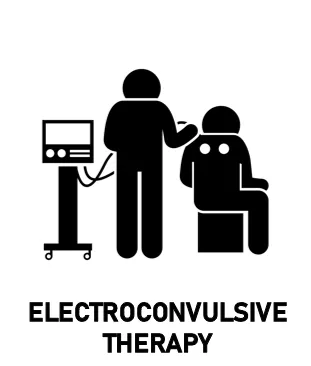Electroconvulsive Therapy (ECT) – also known as “shock treatment” is a treatment that involves an electric current being sent through the brain of an individual.
The aim is to trigger an epileptic seizure, with the ultimate objective to relieve symptoms of a mental health problem. The human body is fully restrained during the procedure, which also involves a general anaesthetic.
Electroconvulsive Therapy is generally seen as a last resort – something that is used if all other interventions have been exhausted.
However, Electroconvulsive Therapy actually has an impressive efficacy rate, with many people finding it helps immeasurably.

The Science Behind Electroconvulsive Therapy
It isn’t entirely known how ECT exactly works in terms of relieving symptoms. ECT causes an epileptic seizure, which involves up to 120 volts of electricity being applied to a patient’s head – leading to a direct current passing through the brain.
Typically, electrodes will be placed on the forehead of a patient, though this can change depending on the circumstances.
This process takes place on a few occasions – generally two-three times a week until symptoms have been relieved.
ECT affects the frontal lobes, which subsequently appear to affect other parts of the brain.
The most prominent theory explaining ECT’s effectiveness is the idea that ECT may correct the imbalance in chemicals within the brain – which appears to contribute to mental illness developing.
How Does Electroconvulsive Therapy Work?
ECT always requires consent prior to being done, (apart from if an individual needs emergency treatment or cannot give their consent when required) even if an individual is detained under the mental health act.
A patient will be told how to prepare for ECT by a doctor, this includes avoiding certain foods and medications. Tests to ascertain overall health are also taken.
A patient receives some form of muscle relaxant prior to therapy – this stops the body from making violent and unpredictable movements during the treatment.
ECT seems to ‘reset’ the brain of an individual, ridding them of their symptoms in some cases. A person will normally attend 2-3 sessions a week for around 4 weeks, though this can change depending on symptoms.
ECT does need a patient to comply with the instructions laid out by a Doctor both before and after the treatment. This includes avoiding certain foods and medications.
A lot of people will finish ECT with a big reduction in their symptoms. Most people will find they have at least a moderate lessening of symptoms.
However, others may not find any benefit at all, and some will relapse in the future. If required, people can return to have ECT again in the future.
When is Electroconvulsive Therapy Useful?
Gone are the days when ECT was routinely used as a treatment, though it still has a place in modern-day treatment.
Normally though, ECT is only used when all other forms of treatment have been tried without success.
For those with treatment-resistant conditions – which may involve a lack of relief despite multiple medications and therapies being tried – ECT can be useful.
If someone is in a catatonic state, this too can be an effective way of getting a patient out of this harmful setting. Also, if a person is having a prolonged episode of mania or psychosis, ECT appears to be capable of stopping this.
Any individual who is in crisis, at risk of imminent suicide or has a severe mental health condition may receive ECT in an effort to lessen symptoms.
In cases where a pregnant woman is severely depressed, ECT is actually among the safest treatments for the unborn child. Given its nature, it appears to be useful for either past or present issues.
How effective is Electroconvulsive Therapy?
ECT tends to be used as a last resort for many psychiatric conditions. While many people consider ECT to be barbaric and dangerous, the results of its treatment are anything but.
While indeed there are risks, such as memory loss and confusion, it can certainly help. A 2012 study found that 50% of people who entered ECT with treatment resistant depression (or a similar condition) found it to be effective in relieving symptoms [1].
However, many people relapse at a later date. It appears that being prescribed antidepressants in the aftermath of ECT can help lessen the chance of a relapse occurring [2].
ECT appears to be effective for catatonia is benzodiazepines have failed [3]. While it is widely used for Schizophrenia around the world, it isn’t entirely clear how effective it is.
How to find a therapist?
It is recommended that you contact your GP and inform them of your problems. They will refer you to the relevant mental health team.
If you are aiming to use the private sector, you could ask your GP or someone you know for a recommendation. You can also look online – the British Association for Counselling and Psychotherapy have a therapist directory on their site.
See Also
- Therapy Home
- Everything You Need To Know About Talking Therapy
- FAQ’s About Talking Therapy
- Electroconvulsive Therapy: Everything You Need to Know
- The Advantages and Disadvantages of Electroconvulsive Therapy
- 8 Things You Should Know About Electroconvulsive Therapy
- Peggy Salters: A Victim of Electroconvulsive Therapy
- Why is Electroconvulsive Therapy so Controversial?
- The Situations Where A Person Can’t Consent to Electroconvulsive Therapy
- The Short and Long Term Side Effects of Electroconvulsive Therapy
- How Do Electroconvulsive Therapy Sessions Work?
- Deciding Whether Or Not To Have Electroconvulsive Therapy
- How Do Repetitive Transcranial Magnetic Stimulation (rTMS) and Electroconvulsive Therapy (ECT) Compare?
Disclaimer
This website should be used purely for informational purposes, and does not intend to, nor should it ever, be used as a replacement for professional medical advice.
We strive to keep all of our pages updated, and ensure that our website is full of factual and in-depth information. However, we encourage you to browse this website with care.
As a reminder, this website and all content within it cannot and should not replace the advice of a trained medical professional. You can read our full disclaimer at this link.
Helplines
If you are struggling with your mental health, help is available. With the right support and treatment, you can make a recovery. For information on helplines, or if you are in a state of crisis, please visit our crisis page by clicking on the relevant link for your geographical location (United Kingdom), (United States), (International). You can also see how to get mental health treatment and the process involved by clicking this link.
References
[1] Dierckx, B., Heijnen, W. T., Van Den Broek, W. W., Birkenhager, T. K. (2012). Efficacy of electroconvulsive therapy versus unipolar major depression: A meta-analysis. Bipolar Disorders. 14 (2): p146-150.
[2] Jelovac, A., Kolshus, E., McLoughlin, D. M. (2013). Relapse Following Successful Electroconvulsive Therapy for Major Depression: A Meta-Analysis. Neuropsychopharmacology. 38 (12): p2467-2474.
[3] Malur, C., Pasol, E., & Francis, A. (2001). ECT for Prolonged Catatonia. The Journal of ECT. 17 (1): p55-59.



































